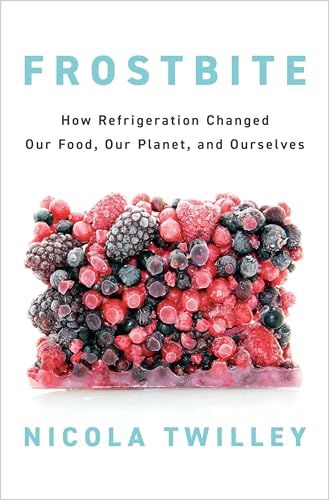Gastropod podcaster Nicola Twilley provides a surprisingly compelling history of keeping food cold.

Best Served Cold
Revolutionary Refrigeration
Award-winning Gastropod podcaster Nicola Twilley — also the co-author of Until Proven Safe: The History and Future of Quarantine, from The Black Death to the Space Age — offers a wide-ranging, business-based history of refrigeration. She explains that taking control of keeping food cold changed humanity’s relationship to the nature of food, and the how, where, and when of its production and distribution.
Today’s refrigerated food supply chain — from home fridges to cooled warehouses, delivery vehicles, shipping containers, and supermarket cases — generally functions outside consumers’ notice, though it is critically important to them.
The refrigerated warehouse is the missing middle in food’s journey from farm to table: a black box whose mysterious internal workings allow perishable food to conquer the constraints of both time and space.Nicola Twilley
In the absence of synthetic preservation techniques, meat, fruits, and vegetables are subject to decomposition — that is, rot. Rot breaks food down into its component elements, renders it inedible quickly, and – by recycling its atoms – ensures the continual regeneration of life on Earth.
Yak Jerky?
Long ago, humankind developed methods for preserving food in an edible state. The oldest method is probably drying, using sunlight and wind to dehydrate food. This technique dates back to 12,000 BC.
Salting and sugaring also eliminate water. Other ancient food preservation techniques, Twilley explains, included smoking meat and fish, processing milk into cheese, and fermenting, which fends off harmful microbes. Canning developed in the Napoleonic era.
In the early 19th century, New England entrepreneur Frederic Tudor pioneered commercial ice production. He devised an above-ground icehouse –a wood structure with double walls filled with sawdust for insulation and a pitched roof that dispersed the heat given off by melting ice — maintained ice in its frozen state for distribution and sales. Within a few decades, Tudor and his competitors were shipping ice to the US East Coast, London, and Calcutta.
Absence of Heat
With the ice trade flourishing, inventors began exploring creating cold artificially. Actually, mechanical refrigeration does not generate cold; instead, it removes heat from a container.
Scottish physician William Cullen developed the basic process of refrigeration in the 18th century, and today’s refrigeration utilizes his principles. A refrigerant gas runs through a loop of tubing, absorbing heat from inside the refrigerator. The tubing continues outside the refrigerator, dumps the heat into the air, and then returns to the refrigerator’s interior to repeat the process. Cullen tried for years before he managed to build the first machine that could create ice from water.
After years of tinkering – early attempts used vinegar, brandy, mint, and even chili oil as a refrigerant – [Cullen] succeeded in creating the first device capable of turning water into ice on demand.Nicola Twilley
In the 19th century, journalist and inventor James Harrison further mechanized and commercialized ice-making. He sold a steam-powered device employing ether as a refrigerant. People used refrigeration to create ice until beer manufacturers developed the method of using cooling pipes to cool beer directly – and, later, to cool entire storage rooms.
Twilley explains that before refrigerated train cars, railways enabled the delivery of meat from farms to remote locations, including cities, by hauling cows, not steaks and chopped beef. Trains and steamships transported live animals, which butchers slaughtered upon arrival. The mid-19th century’s ice-cooled railroad cars weren’t up to the task of preserving cuts of meat on journeys of a week or more. Yet, shipping live animals was expensive and slaughtering them within cities was a dirty, smelly business.
That changed between 1879 and 1882 when builders outfitted steamships with compact Bell-Coleman refrigeration units. These units allowed the ships to deliver butchered meat to London from New York, Australia, and New Zealand. These developments transformed the livestock industry. From 1870 through 1900, the cattle population in the United States grew from 15 million to 35 million.
In 1937, engineer Fred McKinley Jones designed a refrigeration machine for use in trucks. His Thermo King truck unit enabled drivers to transport frozen, prepared food.
By the mid-1960s, the beef business had relocated from urban stockyards near train tracks to industrial feedlots throughout rural Kansas, Colorado, and Nebraska. Such feedlots raised tens of thousands of steer and housed meatpacking facilities that slaughtered thousands of animals daily.
The next step in the global food chain revolution, Twilley reports, came in 1956 with the debut of conventional non-refrigerated shipping containers. However, food distributors who required marine transport could not join the container revolution until the next decade, with the advent of Carrier’s refrigeration units, which were installed on the interior wall of shipping containers. The first “refrigerated, intermodal containers,” or “reefers,” were in service by 1968.
Environmental Effects
The world wastes fully 2.76 billion tons of food, 40% of global production, each year. That food could feed 950 million people annually. In developed nations, waste occurs in homes and restaurants. Developing countries that do not yet have an effective cold supply chain lose half their food yield.
Additionally, Twilley makes it clear that the cold preservation of food comes with an environmental price tag. The chemicals used in refrigeration and the fossil fuels needed to generate the necessary energy produce more than 2% of global greenhouse emissions. Refrigeration and air conditioning together account for 10% of global emissions. Running refrigeration equipment accounts for 8% of global electricity usage.
Refrigerating food for a global population of nine billion using today’s technology would reshape tomorrow’s planetary environment – in the most disastrous manner.Nicola Twilley
Before governments banned CFC refrigerants in 1987, they created a dangerous hole in the ozone layer. Their replacements – HCFCs and HFCs – are greenhouse gases thousands of times more potent than carbon dioxide.
Refrigeration also contributes to environmental problems by changing how people eat. In wealthy nations, refrigeration led to the increased consumption of dairy and meat, further boosting the already high carbon footprint of cattle farming. This problem could become too big to handle if these dietary changes spread throughout the world.
Cold Comfort
Nicola Twilley’s comprehensive, exhaustively researched cold-making opus explores the ice cellars of 18th-century manors, the 19th-century ice industry, the rise of the domestic fridge, and the development of the modern cold supply chain – from refrigerated warehouses to “reefers” to your home kitchen. She writes with wit, enthusiasm, and downright joy in her subject. And Twilley isn’t wrong; refrigeration, in her hands at least, proves to be a great deal of fun. Much of that fun derives from her elegant sentence-making and expert instincts for never dwelling too long on any topic or era. Supply chain participants, chefs, foodies, science nerds, and those interested in the environmental costs of progress will find this a fascinating read.














